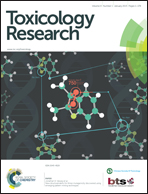Kinetic and density functional theory (DFT) studies of in vitro reactions of acrylamide with the thiols: captopril, l-cysteine, and glutathione†
Abstract
The kinetics for the in vitro reactions of acrylamide (AA), a potentially toxic food contaminant formed during high-temperature food preparation, with captopril (CapSH), L-cysteine (CySH) and glutathione (GSH) were determined under basic conditions and constant ionic strength (pH 7.10–9.10; I = 0.2 mol dm−3, NaCl), and pseudo first-order conditions with respect to AA. The second-order rate constants, k, and activation parameters (ΔH‡, ΔS‡, and ΔG‡) were determined over the ranges of 293 ≤ θ ≤ 303 K for CySH and 303 ≤ θ ≤ 315 K for GSH and CapSH. Comparison of experimental second-order rate constants at 303 K for CapSH, CySH, and GSH were: 0.13 ± 0.01, 0.34 ± 0.02, and 0.18 ± 0.02 dm3 mol−1 s−1, respectively and DFT calculations show evidence of diminished intra-molecular hydrogen abstraction reaction in aqueous solution specific only to GSH. An isokinetic plot of ΔH‡versus ΔS‡ yields an isokinetic temperature of 260 ± 24 K and an intercept, ΔG‡, of 71 ± 4 kJ mol−1 indicating that AA reacts with all three thiols via a similar reaction mechanism. Theoretically determined ΔG‡ values in aqueous solution (DFT-BVP86/Ahlrichs-TZVP/COSMO-RS) for CapSH, CySH, and GSH, including their zero point vibrational energy, are 212.2, 217.8, and 253.4 kJ mol−1, respectively at 298 K.


 Please wait while we load your content...
Please wait while we load your content...